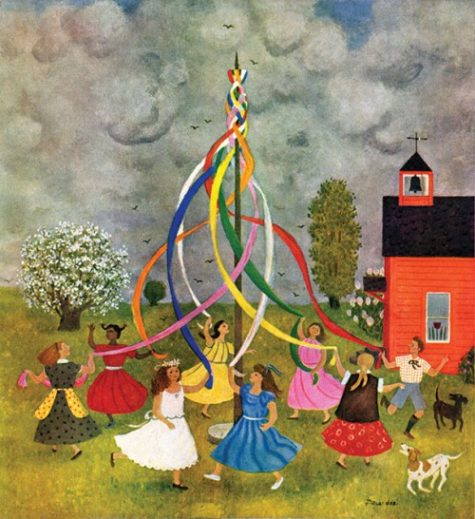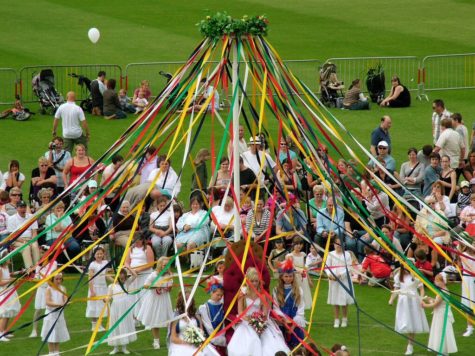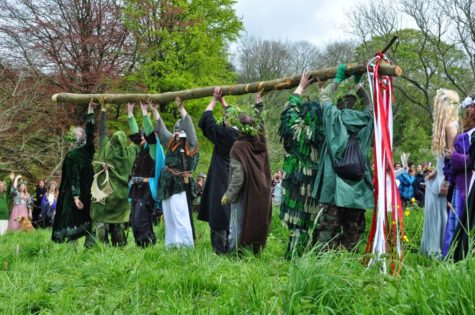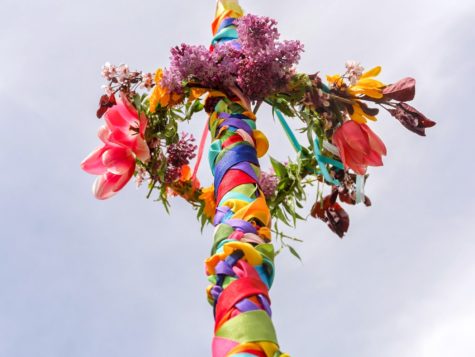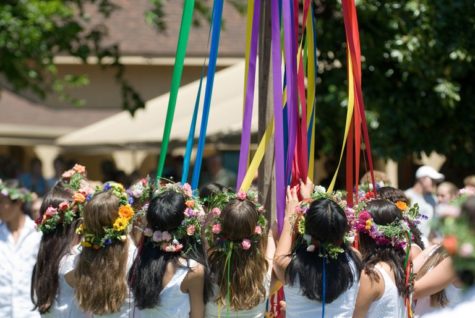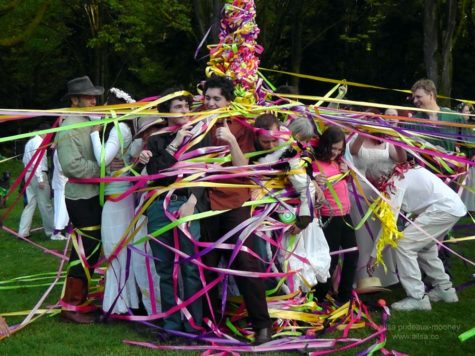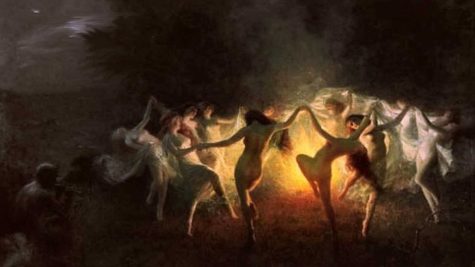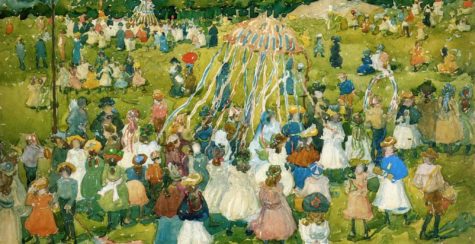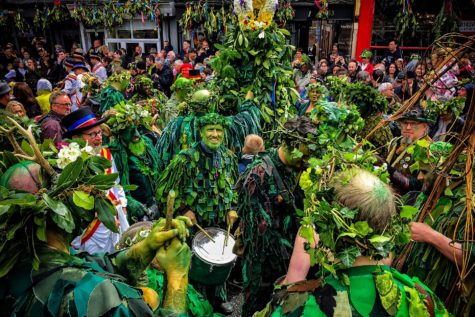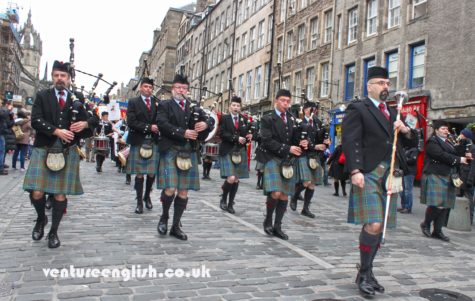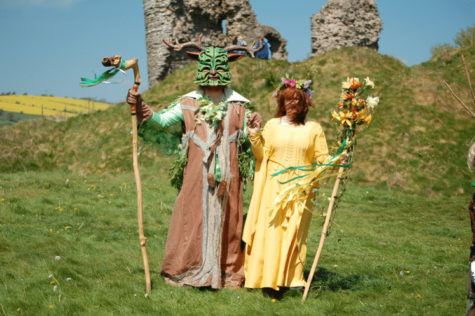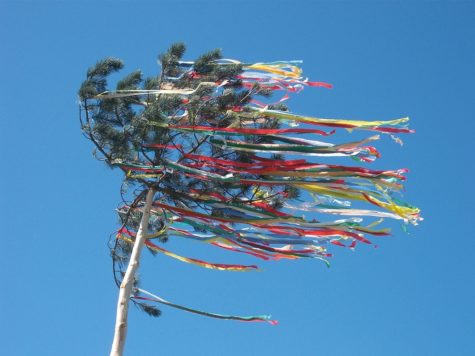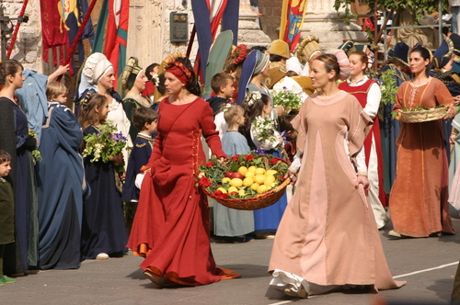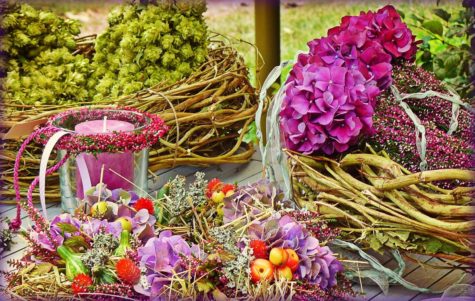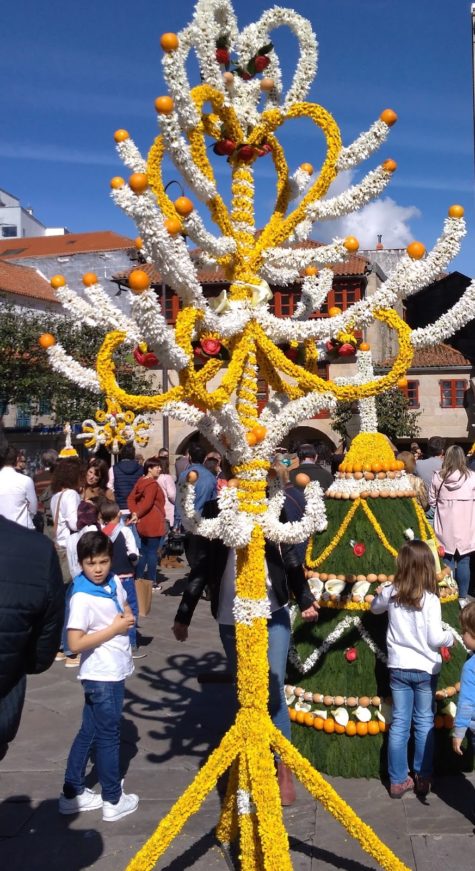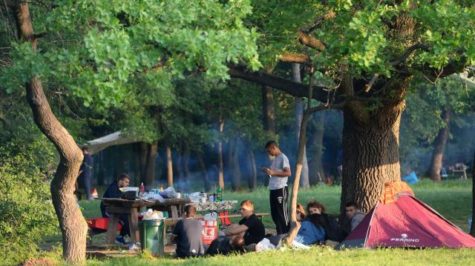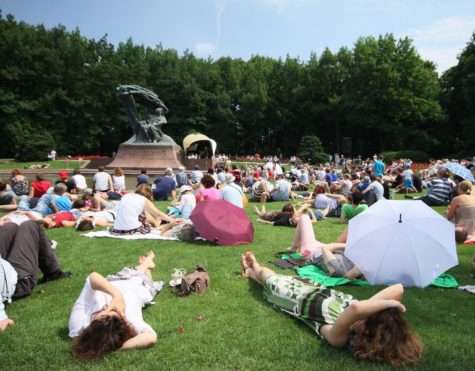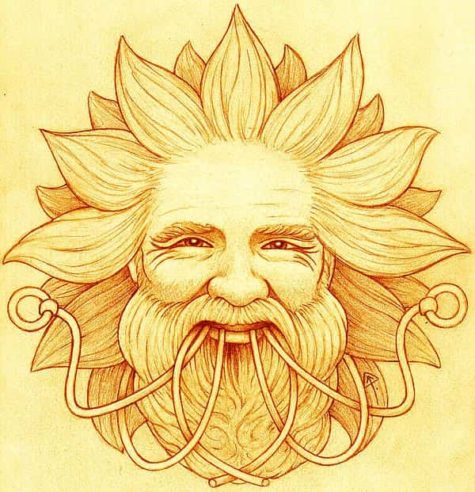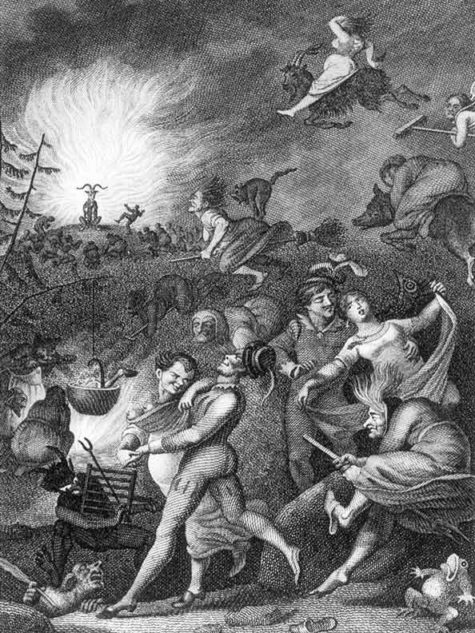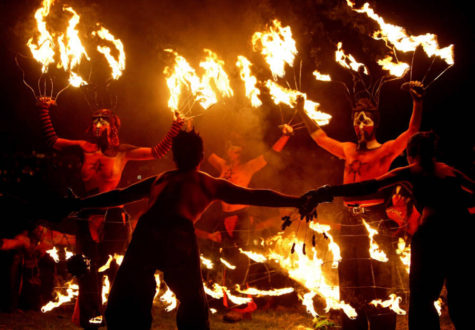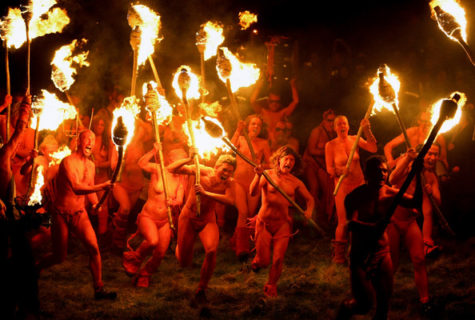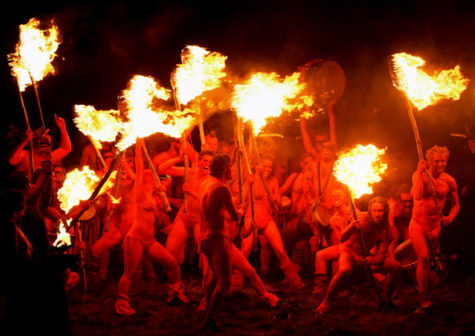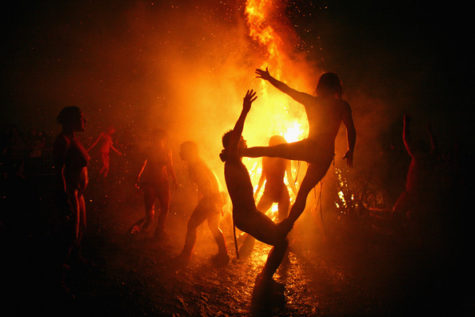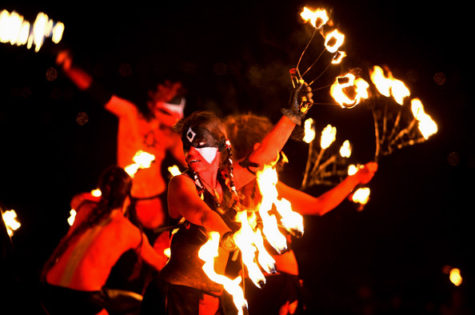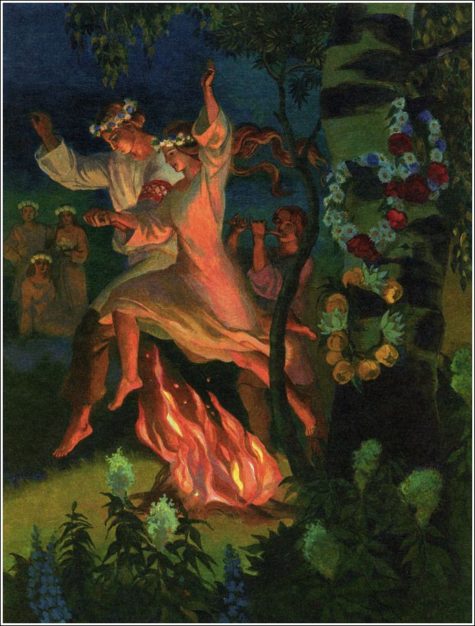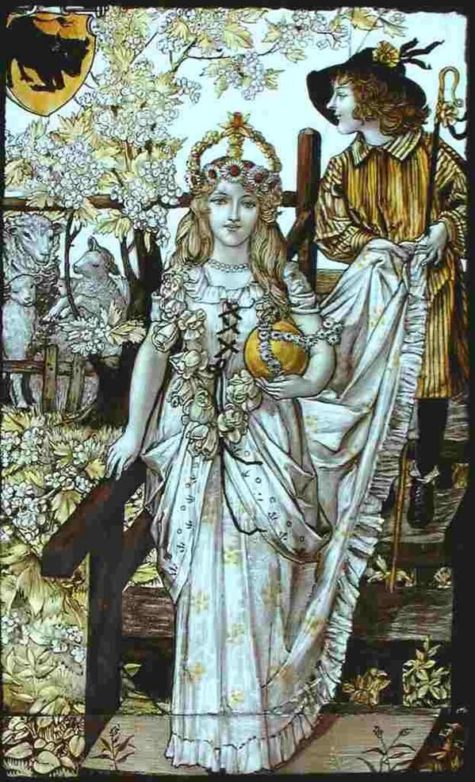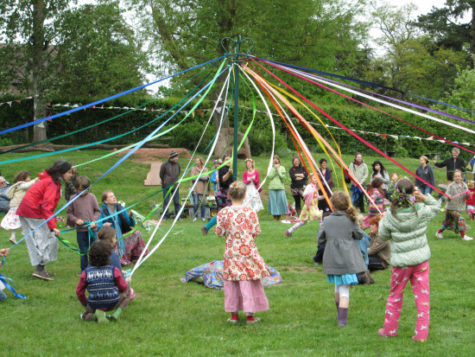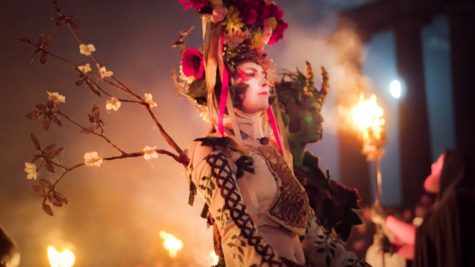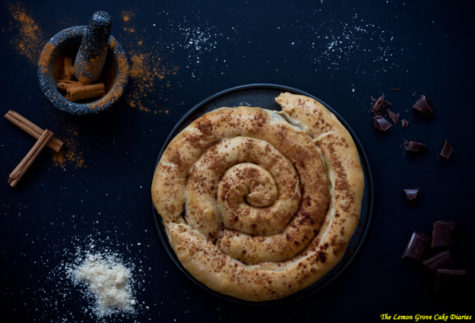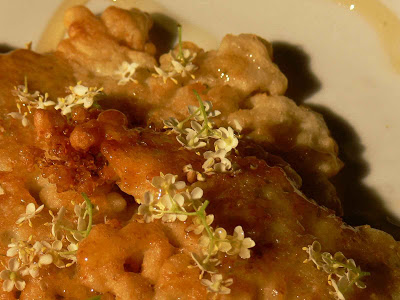Beltane
May Day is a public holiday usually celebrated on 1 May. It is an ancient Northern Hemisphere spring festival and a traditional spring holiday in many cultures. Dances, singing, and cake are usually part of the festivities.
Ancient spring rites that related human fertility to crop fertility gave birth to most modern May Day festivities. May 1 is the traditional day to crown the May queen, dance around the maypole, perform mummers’ plays, and generally celebrate the return of spring. Although our Pilgrim fathers were horrified by these reminders of a pagan past and outlawed all such activities, the maypole dance remains an enduring event.
In Great Britain, the custom of “bringing in the May” involves gathering “knots,” or branches with buds, on the eve or early morning of May 1. In England, a favorite branch is hawthorn. In Scotland and Wales, people choose the rowan, or mountain ash. In North America, we often select forsythia, lilac, or pussy willow branches to bring spring and the prospect of new life into our homes.
The best known modern May Day traditions, observed both in Europe and North America, include dancing around the maypole and crowning the Queen of May. Fading in popularity since the late 20th century is the tradition of giving of “May baskets,” small baskets of sweets or flowers, usually left anonymously on neighbors’ doorsteps.
In the late 20th century, many neopagans began reconstructing some of the older pagan festivals and combining them with more recently developed European secular and Catholic traditions, and celebrating May Day as a pagan religious festival.
The Maypole
It’s impossible to think of Mayday without thinking of the Maypole. This is perhaps one of the most popular symbols of the season, representing the Divine Marriage between the Lord and Lady of the Greenwood. The pole represents the male principle, and the ribbons that wrap around it (and the wreath placed atop the pole) are symbolic of the female principle.
The Maypole represents the phallus of the God. The wreath atop represents the vagina of the Goddess. As the Maypole is danced, the ribbons wind around the pole and the wreath lowers, symbolizing the Divine Marriage, the sexual union of God and Goddess.
The Maypole Dance
The May Day dance is rich in pagan symbolism. There are usually eight dancers, one for each sabbat of the year, paired into four couples. (Of course, many more may dance. This is only a suggestion.) The dance involves moving in circles and weaving over and under the other dancers. The women take the white ribbons with their right sides to the pole, and the men take the red ribbons with their left sides to the pole.
The weaving of the symbolic birth canal begins with music or chanting as everyone moves forward from where they stand, moving alternately over and under each person coming toward them. (To start, the men begin weaving under the upheld ribbon of the first woman they encounter). Continue the dance until the maypole is wrapped. Tie off the ribbons and let the wreath drop to the ground.
Many folks wear bells when dancing the May dance. Make your steps a cross between a skip and a jog, coming down in time to the music, so that the bells mark off the beats of the music or chant.
May Day Chants
We are the flow and we are the ebb
We are the weavers, we are the web
We are the needle, we are the thread
We are the witches, back from the dead
Weavers, weavers,
We are weaving the web of life.
Weave, weave, weave me a rainbow
Out of the falling rain.
Weave me the hope of a new tomorrow.
Fill my cup again
Lady, weave Your circle tight
With a web of living light
Earth and Air and Fire and Water
Bind us to you.
The Pole
The traditional Maypole is a fir tree that has been stripped of all but its uppermost branches (often the trunk of the Yule tree was saved for the Maypole), but traditions vary. Some use oak; others pine. It may range in height from a few feet to as large as you care to make it. (Bear in mind, ribbon will need to be twice as long as the pole.) With unlimited space outdoors, ten feet is a good length. Of course, in a pinch, even a flagpole would do. For those who have restricted space or who have to celebrate indoors, a 3-4 foot dowel inserted in a wooden base and placed upon the altar will work as well.
If you cut a tree for the Maypole, please ask the tree’s permission before cutting and leave an offering at the base. An offering of food, wine, or flowers is entirely appropriate.
The Ribbons
However many ribbons you use, you will need equal numbers of at least two colors, depending on the number of dancers you’ll have. I recommend at least 6-8 dancers. Ribbons for the pole should be twice as long as the pole and about two to three inches wide. Colors vary according to preference. Traditional colors are red for the God and white for the virgin Goddess. Some use colors of the season — hunter green for the forest, gold for the sun, or purple for the color of grapes and wine. I’ve even heard of people using a rainbow of colors to represent the signs of the zodiac. Some traditions request that dancers bring a ribbon in a color representing a certain blessing they might wish for.
The ribbons can be tied just below the topmost branches of the tree or adhered to the top of the pole with thumbtacks, nails, or glue. In Dancing with the Sun, Yasmine Galenorn recommends making crosscuts on the top end of the pole, tying knots on the end of each ribbon, and threading the ribbons through the slits at the top of the pole. The knots will keep the ribbon from sliding out of the slits as it is woven around the pole.
The Wreath
The wreath should be made on Beltane morning. It is traditional to go to the fields to gather May flowers at this time. Fashion a wreath from greenery and decorate with the first blooms of the season. It must be somewhat bigger than the top of the maypole, taking into account any branches you left at the top, in order that it may fall down the pole as the ribbons are wound.
Consecrate the Maypole
Erection of the Maypole should be carried out with great fanfare. Once the tree has been selected, cut down, and the branches removed, it might be carried in processional to the dance site. Next, a hole must be dug. Pour an offering of water with a pinch of salt or a purifying herb like rosemary into the opening with words like:
Earth Mother, may this offering
Prepare you to receive
This symbol of your consort, our Lord.
Next, anoint the Maypole itself, using altar oil or a mixture of any of the following: myrrh, musk, and/or sweet woodruff. With the oil, make the sign of the solar cross, or the Rune inguz, a rune related to the annual “king’s circuit,” or walking of the land, to ensure the fertility of the land:
At each anointing, say:
Blessed be this tree,
Vehicle of our Lord
Which shall soon enter
Our Mother, the Earth.
When the Maypole has been erected and decorated, light the balefire and celebrate!
Historical May Day Celebrations
The earliest known May celebrations appeared with the Floralia, festival of Flora, the Roman goddess of flowers, held on 27 April during the Roman Republic era, and the Maiouma or Maiuma, a festival celebrating Dionysus and Aphrodite on an unknown date in May every three years. The Floralia opened with theatrical performances. In the Floralia, Ovid says that hares and goats were released as part of the festivities. Persius writes that crowds were pelted with vetches, beans, and lupins. A ritual called the Florifertum was performed on either April 27 or May 3, during which a bundle of wheat ears was carried into a shrine, though it is not clear if this devotion was made to Flora or Ceres. Floralia concluded with competitive events and spectacles, and a sacrifice to Flora.
According to the 6th century chronicles of John Malalas, the Maiouma was a “nocturnal dramatic festival, held every three years and known as Orgies, that is, the Mysteries of Dionysus and Aphrodite” and that it was “known as the Maioumas because it is celebrated in the month of May-Artemisios”. During this time, enough money was set aside by the government for torches, lights, and other expenses to cover a thirty-day festival of “all-night revels.” The Maiouma was celebrated with splendorous banquets and offerings. Its reputation for licentiousness caused it to be suppressed during the reign of Emperor Constantine, though a less debauched version of it was briefly restored during the reigns of Arcadius and Honorius, only to be suppressed again during the same period.
A later May festival celebrated in Germanic countries, Walpurgis Night, commemorates the official canonization of Saint Walpurga on May 1st, 870. In Gaelic culture, the evening of April 30th was the celebration of Beltane (which translates to “lucky fire”), the start of the summer season. First attested in 900 AD, the celebration mainly focused on the symbolic use of fire to bless cattle and other livestock as they were moved to summer pastures. This custom continued into the early 19th century, during which time cattle would be made to jump over fires to protect their milk from being stolen by fairies. People would also leap over the fires for luck.
May Day was abolished and its celebration banned by Puritan parliaments during the Interregnum, but reinstated with the restoration of Charles II in 1660. 1 May 1707, was the day the Act of Union came into effect, joining England and Scotland to form the Kingdom of Great Britain.
Queen Guinevere’s Maying, by John Collier
For thus it chanced one morn when all the court,
Green-suited, but with plumes that mocked the may,
Had been, their wont, a-maying and returned,
That Modred still in green, all ear and eye,
Climbed to the high top of the garden-wall
To spy some secret scandal if he might,
Since the 18th century, many Roman Catholics have observed May – and May Day – with various May devotions to the Blessed Virgin Mary. In works of art, school skits, and so forth, Mary’s head will often be adorned with flowers in a May crowning. 1 May is also one of two feast days of the Catholic patron saint of workers St Joseph the Worker, a carpenter, husband to Mother Mary, and surrogate father of Jesus. Replacing another feast to St. Joseph, this date was chosen by Pope Pius XII in 1955 as a counterpoint to the communist International Workers Day celebrations on May Day.
In the late 19th century, May Day was chosen as the date for International Workers’ Day by the Socialists and Communists of the Second International to commemorate the Haymarket affair in Chicago. International Workers’ Day can also be referred to as “May Day”, but it is a different celebration from the traditional May Day.
May Day Celebrations Around The World
- England
Traditional English May Day rites and celebrations include crowning a May Queen and celebrations involving a maypole, around which dancers often circle with ribbons. Historically, Morris dancing has been linked to May Day celebrations. The earliest records of maypole celebrations date to the 14th century, and by the 15th century the maypole tradition was well established in southern Britain.
In Oxford, it is a centuries-old tradition for May Morning revellers to gather below the Great Tower of Magdalen College at 6 am to listen to the college choir sing traditional madrigals as a conclusion to the previous night’s celebrations. Since the 1980s some people then jump off Magdalen Bridge into the River Cherwell. For some years, the bridge has been closed on 1 May to prevent people from jumping, as the water under the bridge is only 2 feet (61 cm) deep and jumping from the bridge has resulted in serious injury in the past. There are still people who climb the barriers and leap into the water, causing themselves injury.
In Durham, students of the University of Durham gather on Prebend’s Bridge to see the sunrise and enjoy festivities, folk music, dancing, madrigal singing and a barbecue breakfast. This is an emerging Durham tradition, with patchy observance since 2001.
Whitstable, Kent, hosts a good example of more traditional May Day festivities, where the Jack in the Green festival was revived in 1976 and continues to lead an annual procession of Morris dancers through the town on the May bank holiday.
A separate revival occurred in Hastings in 1983 and has become a major event in the town calendar. A traditional sweeps festival is performed over the May bank holiday in Rochester, Kent, where the Jack in the Green is woken at dawn on 1 May by Morris dancers.
At 7:15 p.m. on 1 May each year, the Kettle Bridge Clogs Morris dancing side dance across Barming Bridge (otherwise known as the Kettle Bridge), which spans the River Medway near Maidstone, to mark the official start of their Morris dancing season.
Also known as Ashtoria Day in northern parts of rural Cumbria. A celebration of unity and female bonding. Although not very well known, it is often cause for huge celebration.
Padstow in Cornwall holds its annual Obby-Oss (Hobby Horse) day of festivities. This is believed to be one of the oldest fertility rites in the UK; revellers dance with the Oss through the streets of the town and even through the private gardens of the citizens, accompanied by accordion players and followers dressed in white with red or blue sashes who sing the traditional “May Day” song. The whole town is decorated with springtime greenery, and every year thousands of onlookers attend. Prior to the 19th-century, distinctive May Day celebrations were widespread throughout west Cornwall, and are being revived in St. Ives and Penzance.
Kingsand, Cawsand and Millbrook in Cornwall celebrate Flower Boat Ritual on the May Day bank holiday. A model of the ship The Black Prince is covered in flowers and is taken in procession from the Quay at Millbrook to the beach at Cawsand where it is cast adrift. The houses in the villages are decorated with flowers and people traditionally wear red and white clothes. There are further celebrations in Cawsand Square with Morris dancing and May pole dancing.
- Scotland
May Day has been celebrated in Scotland for centuries. It was previously closely associated with the Beltane festival. Reference to this earlier celebration is found in poem ‘Peblis to the Play’, contained in the Maitland Manuscripts of fifteenth- and sixteenth-century Scots poetry:
At Beltane, quhen ilk bodie bownis
To Peblis to the Play,
To heir the singin and the soundis;
The solace, suth to say,
Be firth and forrest furth they found
Thay graythis tham full gay;
God wait that wald they do that stound,
For it was their feist day,
Thay said, […]
The poem describes the celebration in the town of Peebles in the Scottish Borders, which continues to stage a parade and pageant each year, including the annual ‘Common Riding’, which takes place in many towns throughout the Borders. As well as the crowning of a Beltane Queen each year, it is custom to sing ‘The Beltane Song’.
In Edinburgh, the Beltane Fire Festival is held on the evening of May eve and into the early hours of May Day on the city’s Calton Hill. An older Edinburgh tradition has it that young women who climb Arthur’s Seat and wash their faces in the morning dew will have lifelong beauty. At the University of St Andrews, some of the students gather on the beach late on April 30 and run into the North Sea at sunrise on May Day, occasionally naked. This is accompanied by torchlit processions and much elated celebration.
- Wales
In Wales the first day of May is known as Calan Mai or Calan Haf, and parallels the festival of Beltane and other May Day traditions in Europe.
Traditions would start the night before (Nos Galan Haf) with bonfires, and is considered a Ysbrydnos or spirit night when people would gather hawthorn and flowers to decorate their houses, celebrating new growth and fertility. While on May Day celebrations would include summer dancing and May carols other times referred to as “singing under the wall”, May Day was also a time for officially opening a village green.
- Finland
In Finland, Walpurgis night (Vappu) (“Vappen”) is one of the four biggest holidays along with Christmas Eve, New Year’s Eve, and Midsummer. Walpurgis witnesses the biggest carnival-style festival held in Finland’s cities and towns. The celebrations, which begin on the evening of 30 April and continue on 1 May, typically centre on the consumption of sima, sparkling wine and other alcoholic beverages.
Student traditions, particularly those of engineering students, are one of the main characteristics of Vappu. Since the end of the 19th century, this traditional upper-class feast has been appropriated by university students. Many university-preparatory high school alumni wear the black and white student cap and many higher education students wear student coveralls. One tradition is to drink sima, a home-made low-alcohol mead, along with freshly cooked funnel cakes.
- France
On 1 May 1561, King Charles IX of France received a lily of the valley as a lucky charm. He decided to offer a lily of the valley each year to the ladies of the court. At the beginning of the 20th century, it became custom to give a sprig of lily of the valley, a symbol of springtime, on 1 May. The government permits individuals and workers’ organisations to sell them tax-free on that single day. Nowadays, people may present loved ones either with bunches of lily of the valley or dog rose flowers.
- Germany
In rural regions of Germany, especially the Harz Mountains, Walpurgisnacht celebrations of pagan origin are traditionally held on the night before May Day, including bonfires and the wrapping of a Maibaum (maypole). Young people use this opportunity to party, while the day itself is used by many families to get some fresh air. Motto: “Tanz in den Mai” (“Dance into May”).
In the Rhineland, 1 May is also celebrated by the delivery of a maypole, a tree covered in streamers to the house of a girl the night before. The tree is typically from a love interest, though a tree wrapped only in white streamers is a sign of dislike. Women usually place roses or rice in the form of a heart at the house of their beloved one. It is common to stick the heart to a window or place it in front of the doormat. In leap years, it is the responsibility of the women to place the maypole. All the action is usually done secretly and it is an individual’s choice whether to give a hint of their identity or stay anonymous.
- Ireland
May Day has been celebrated in Ireland since pagan times as the feast of Beltane (Bealtaine) and in latter times as Mary’s day. Traditionally, bonfires were lit to mark the coming of summer and to grant luck to people and livestock. Officially Irish May Day holiday is the first Monday in May. Old traditions such as bonfires are no longer widely observed, though the practice still persists in some places across the country.
- Italy
In Italy it is called Calendimaggio or cantar maggio a seasonal feast held to celebrate the arrival of spring. The event takes its name from the period in which it takes place, that is, the beginning of May, from the Latin calenda maia. The Calendimaggio is a tradition still alive today in many regions of Italy as an allegory of the return to life and rebirth. This magical-propitiatory ritual is often performed during an almsgiving in which, in exchange for gifts (traditionally eggs, wine, food or sweets), the Maggi (or maggerini) sing auspicious verses to the inhabitants of the houses they visit.
Throughout the Italian peninsula these Il Maggio couplets are very diverse—most are love songs with a strong romantic theme, that young people sang to celebrate the arrival of spring. Symbols of spring revival are the trees (alder, golden rain) and flowers (violets, roses), mentioned in the verses of the songs, and with which the maggerini adorn themselves. In particular the plant alder, which grows along the rivers, is considered the symbol of life and that’s why it is often present in the ritual.
Calendimaggio can be historically noted in Tuscany as a mythical character who had a predominant role and met many of the attributes of the god Belenus. In Lucania, the Maggi have a clear auspicious character of pagan origin. In Syracuse, Sicily, the Albero della Cuccagna (cf. “Greasy pole”) is held during the month of May, a feast celebrated to commemorate the victory over the Athenians led by Nicias. However, Angelo de Gubernatis, in his work Mythology of Plants, believes that without doubt the festival was previous to that of said victory.
It is a celebration that dates back to ancient peoples, and is very integrated with the rhythms of nature, such as the Celts (celebrating Beltane), Etruscans and Ligures, in which the arrival of summer was of great importance.
- Greece
Maios (Latin Maius), the month of May, took its name from the goddess Maia (Gr Μαία, the nurse), a Greek and Roman goddess of fertility. The day of Maios (Modern Greek Πρωτομαγιά) celebrates the final victory of the summer against winter as the victory of life against death. The celebration is similar to an ancient ritual associated with another minor demi-god Adonis which also celebrated the revival of nature.
There is today some conflation with yet another tradition, the revival or marriage of Dionysus (the Greek God of theatre and wine-making). This event, however, was celebrated in ancient times not in May but in association with the Anthesteria, a festival held in February and dedicated to the goddess of agriculture Demeter and her daughter Persephone. Persephone emerged every year at the end of Winter from the Underworld. The Anthesteria was a festival of souls, plants and flowers, and Persephone’s coming to earth from Hades marked the rebirth of nature, a common theme in all these traditions.
What remains of the customs today, echoes these traditions of antiquity. A common, until recently, May Day custom involved the annual revival of a youth called Adonis, or alternatively of Dionysus, or of Maios (in Modern Greek Μαγιόπουλο, the Son of Maia). In a simple theatrical ritual, the significance of which has long been forgotten, a chorus of young girls sang a song over a youth lying on the ground, representing Adonis, Dionysus or Maios. At the end of the song, the youth rose up and a flower wreath was placed on his head.
The most common aspect of modern May Day celebrations is the preparation of a flower wreath from wild flowers, although as a result of urbanisation there is an increasing trend to buy wreaths from flower shops. The flowers are placed on the wreath against a background of green leaves and the wreath is hung either on the entrance to the family house/apartment or on a balcony. It remains there until midsummer night.
On that night, the flower wreaths are set alight in bonfires known as St John’s fires. Youths leap over the flames consuming the flower wreaths. This custom has also practically disappeared, like the theatrical revival of Adonis/Dionysus/Maios, as a result of rising urban traffic and with no alternative public grounds in most Greek city neighbourhoods, not to mention potential conflicts with demonstrating workers.
- Bulgaria
On May Day, Bulgarians celebrate Irminden (or Yeremiya, Eremiya, Irima, Zamski den). The holiday is associated with snakes and lizards and rituals are made in order to protect people from them. The name of the holiday comes from the prophet Jeremiah, but its origins are most probably pagan.
It is said that on the days of the Holy Forty or Annunciation snakes come out of their burrows, and on Irminden their king comes out. Old people believe that those working in the fields on this day will be bitten by a snake in summer.
In western Bulgaria people light fires, jump over them and make noises to scare snakes. Another custom is to prepare “podnici” (special clay pots made for baking bread).
This day is especially observed by pregnant women so that their offspring do not catch “yeremiya” — an illness due to evil powers.
- Romania
On May Day, the Romanians celebrate the arminden (or armindeni), the beginning of summer, symbolically tied with the protection of crops and farm animals. The name comes from Slavonic Jeremiinŭ dĭnĭ, meaning prophet Jeremiah’s day, but the celebration rites and habits of this day are apotropaic and pagan (possibly originating in the cult of the god Pan).
The day is also called ziua pelinului (“mugwort day”) or ziua bețivilor (“drunkards’ day”) and it is celebrated to ensure good wine in autumn and, for people and farm animals alike, good health and protection from the elements of nature (storms, hail, illness, pests). People would have parties in natural surroundings, with lăutari (fiddlers) for those who could afford it. Then it is customary to roast and eat lamb, along with new mutton cheese, and to drink mugwort-flavoured wine, or just red wine, to refresh the blood and get protection from diseases. On the way back, the men wear lilac or mugwort flowers on their hats.
Other rites include, in some areas of the country, people washing their faces with the morning dew (for good health) and adorning the gates for good luck and abundance with green branches or with birch saplings (for the houses with maiden girls). The entries to the animals’ shelters are also adorned with green branches. All branches are left in place until the wheat harvest when they are used in the fire which will bake the first bread from the new wheat.
On May Day eve, country women do not work in the field as well as in the house to avoid devastating storms and hail coming down on the village.
Arminden is also ziua boilor (oxen day) and thus the animals are not to be used for work, or else they could die or their owners could get ill.
It is said that the weather is always good on May Day to allow people to celebrate.
- Portugal
“Maias” is a superstition throughout Portugal, with special focus on the northern territories and rarely elsewhere. It may also be referred to by other names, including Dia das Bruxas (Witches’ day), O Burro (the Donkey, referring to an evil spirit) or the last of April, as the local traditions preserved to this day occur on that evening only.
People put the yellow flowers of Portuguese brooms, the bushes are known as giestas. The flowers of the bush are known as Maias, which are placed on doors or gates and every doorway of houses, windows, granaries, currently also cars, which the populace collect on the evening of the 30th of April when the Portuguese brooms are blooming, to defend those places from bad spirits, witches and the evil eye. The placement of the May flower or bush in the doorway must be done before midnight.
These festivities are a continuum of the “Os Maios” of Galiza. In ancient times, this was done while playing traditional night-music. In some places, children were dressed in these flowers and went from place to place begging for money or bread. On the 1st of May, people also used to sing “Cantigas de Maio”, traditional songs related to this day and the whole month of May.
- Serbia
“Prvomajski uranak” (Reveille on May 1st) is a folk tradition and feast that consists of the fact that on May 1, people go in the nature or even leave the day before and spend the night with a camp fire. Most of the time, a dish is cooked in a kettle or in a barbecue. Among Serbs this holiday is widespread. Almost every town in Serbia has its own traditional first-of-may excursion sites, and most often these are green areas outside the city.
- Poland
In Poland, there is a state holiday on 1 May. It is currently celebrated without a specific connotation, and as such it is May Day. However, due to historical connotations, most of the celebrations are focused around Labor Day festivities. It is customary for labor activists and left-wing political parties to organize parades in cities and towns across Poland on this day. The holiday is also commonly referred to as “Labour Day” (“Święto Pracy”).
- Czech Republic
In Czech Republic, May Day is traditionally considered as a holiday of love and May as a month of love. The celebrations of spring are held on April 30th when a maypole (“májka” in Czech) is lifted—a tradition possibly connected to Beltane, since bonfires are also lit on that day. The event is similar to German Walpurgisnacht. It’s public holiday on April 30th. On May 31st, the maypole is taken down in an event called Maypole Felling.
On 1 May, couples in love are kissing under a blooming tree. A cherry, an apple or a birch is most often considered a suitable tree.
- United States
May Day was also celebrated by some early European settlers of the American continent. In some parts of the United States, May baskets are made. These are small baskets usually filled with flowers or treats and left at someone’s doorstep. The giver rings the bell and runs away.
- Hawaii
In Hawaii, May Day is also known as Lei Day, and it is normally set aside as a day to celebrate island culture in general and the culture of the Native Hawaiians in particular. Invented by poet and local newspaper columnist Don Blanding, the first Lei Day was celebrated on 1 May 1927 in Honolulu. Leonard “Red” and Ruth Hawk composed “May Day Is Lei Day in Hawai’i,” the traditional holiday song.
Sources:
- Wikipedia
- Dancing with the Sun by Yasmine Galenorn
- The Sabbats by Edain McCoy
- Ancient Ways by Pauline Campanelli
- Earth Witchery
- Almanac.com
Belenus, whose name means “Bright One,” was one of the most ancient of Celtic gods. The Celtic fire festival, held on the eve of the first of May, known as Beltane, (the fires of Bel) is probably derived from the name of this deity. Beltane fires were lit to encourage the sun’s warmth. These fires also had restorative properties and cattle were herded between them before being loosed on the new spring pastures.
Closely connected to the Druids, ruler of science, healing, hot springs, fire, success, prosperity, purification, crops, vegetation, fertility. It is likely that Belenus (Bel, or Beli) was a fire deity, a patron of flame and the sun’s restorative powers (which explains his classical association with Apollo). Originally he may have been a pastoral deity and in Cymric myth is associated with cattle, sheep and crops. Though this may be because Beltane was the time that herds were moved to the high pastures.
The Celtic god of light and healing, “Bel” means “shining one,” or in Irish Gaelic, the name “bile” translates to “sacred tree.” It is thought that the waters of Danu, the Irish All-Mother goddess, fed the oak and produced their son, The Dagda. As the Welsh Beli, he is the father of Arianrhod by Don.
Patron of sheep and cattle, Bel’s festival is Beltane, one of two main Celtic fire festivals. Beltane celebrates the return of life and fertility to the world — marking the beginning of Summer and the growing season.
Taking place on April 30 (May Eve) and in some areas on May 1, Beltane also is sometimes referred to as “Cetsamhain” which means “opposite Samhain.” The word “Beltaine” literally means “bright” or “brilliant fire,” and refers to the bonfire lit by a presiding Druid in honor of Bile.
Found at: Encyclopedia Mythica
For the purpose of your magical escapades, the theme is definitely blossoming and liveliness. Use as many flower parts as possible in spells and rituals, and go outside frequently to get closer to nature. Energies emphasized by this month include creativity, inventiveness, fertility, health, and metaphysically “spring cleaning” any area of your life or sacred space.
Bring me my drum and bring me my cymbal,
Bring forth the sustrum, bring forth the timbal.
Dance now for Hathor, celebrate beauty,
dance in Her honor, sing for our lady.
May gets its name from the Roman goddess Maia, who embodies the earth’s renewal during spring. Next to New Year’s Eve, May Day was among the most popular holidays in the old world, marking the time when the sun’s warmth and nature’s fertility began appearing in the land. Later, well over one hundred nations chose to celebrate Labor Day on May 1, giving everyone a much-needed rest from winter’s tasks.
The Greek goddess Maia, the most important of the Seven Sisters (the Pleiades) and said to be the mother of Hermes, gave the name to this month. Some form of this goddess’s name was known to people from Ireland to as far away as India. The Romans called her Maius, goddess of Summer and honored her at the Ambarvalia, a family festival for purification and protection of farm land.
In the Celtic cultures, May was called Mai or Maj, a month of sexual freedom. Green was worn during this month to honor the Earth Mother. May 1 was the Celtic festival of Beltane, a festival celebrating fertility of all things. Cattle were drivien through the Beltane bonfires for purification and fertility. In Wales, Creiddylad was connected with this festival and often called the May Queen. The maypole and its dance is a remnant of these old festivities.
The Sheila Na Gig is still seen carved in the decorations of many Irish churches. This goddess figure is a grotesque, often emaciated, woman shown squatting and holding wide her private parts. Many Irish still know her as the protector of the poor and hang old clothes on hawthorn bushes on May 4th. This is believed to avert poverty. It is possible that the Australian term “Sheila,” used as a name for any woman, refers to this ancient deity and her carvings.
Bona Dea, the Roman Good Goddess, had her festival on the night between may 2nd and 3rd. No men were allowed to attend.
The Roman festival of Lemuria was to placate and remember the Lemures, or the wandering spirits of the dead. Each family performed its own private ceremonies, which ended with taking gifts to the graves. For those who had died and had no graves, the head of the household walked barefoot through the house, casting nine black beans behind him.
The Greeks had a special festival for the god Pan during May. Pan was a wild looking deity, half man, half goat. As a token of his frequent sexual adventures, he was shown with an erect penis. Pan invented the syrinx, or pan-pipes, made out of reeds. Originally, he was not an oppressor of women, but their loving companion.
May 19-28 was the solemn Greek festival called Kallyntaria and Plynteria. This was devoted to the cleaning and freshening of sacred statures and temples. The statues, small enough to be moved, were taken to a nearby river or lake and washed until clean. This was serious business with no singing or merry-making.
At the end of the month was a Roman celebration honoring the Underworld Queen Prosperina and her consort Pluto. Proserpina ruled over the resting place of the shades (souls), but her kingdom was connected with more than death. Pluto was also known as the deity of hidden wealth.
In Finland, May 1 was celebrated as Rowan Witch Day, a time of honoring the goddess Rauni, who was associated with the mountain ash or rowan. Twigs and branches of the rowan were, and still are, used as protection against evil in this part of the world. Some sources list Rauni as a god.
The Slavonic-Russian cultures had a similar, but longer, festival celebrating merriment, rivers, and well-being. This occured between May 25 and June 25. Originally it honored the goddess Lada, who later was changed to the god Lado.
Mugwort was a sacred herb in China and Europe. As part of the celebration on May 5, the Chinese made dolls out of the leaves. They hung these dolls above gates and doors to repel negative influences and entities.
In Tibet, an old Nature festival for the beginning of Summer and the rain deities became a celebration of Buddha’s death and his attainment of Buddha-hood. The attainment festival occurred on May 8, while celebration of Buddha’s death was on May 15. Deceased relatives were prayed for at this time.
The Incas held Aymoray Quilla or Hatun Cazqui, which was the Great Cultivation.
From: Moon Magick
In Germany, Walpurgisnacht (or Hexennacht, meaning witches´ night), the night from April 30 (May eve), is the night when allegedly the witches hold a large celebration on the Blocksberg (the highest of the Harz Mountains of north central Germany) hold revels with their Gods, and await the arrival of Spring.
In some parts of northern coastal regions of Germany, the custom of lighting huge Beltane fires is still kept alive, to celebrate the coming of May, while most parts of Germany have a derived christianized custom around Easter called “Easter fires”.
In rural parts of southern Germany it is part of popular youth culture to go out on Walburgisnacht to play pranks on other people, like messing up someone’s garden, hiding stuff or spraying messages on other people’s property. Sometimes these pranks go too far and may result in serious willful damage to property or bodily injury.
Walpurgis (sw: Valborg) is one of the main holidays during the year in both Sweden and Finland, alongside Christmas and Midsummer. The forms of celebration in Sweden vary in different parts of the country and between different cities. One of the main traditions in Sweden is to light large bonfires, a custom which is most firmly established in Svealand, and which began in Uppland during the 18th century. An older tradition from Southern Sweden was for the younger people to collect greenery and branches from the woods at twilight, which were used to adorn the houses of the village. The expected reward for this task is to be paid in eggs.
Today in Finland, Walpurgis Night (Vapunaatto) is, along with New Year’s Eve, the biggest carnival-style festivity that takes place in the streets of Finland’s towns and cities. The celebration is typically centered on plentiful use of sparkling wine and other alcoholic beverages. The student traditions are also one of the main characteristics of “Vappu“. From the end of the 19th century, “Fin de Siècle“, and onwards, this traditional upper class feast has been co-opted by students attending university, already having received their student cap. Many people who have graduated from lukio wear the cap.
One tradition is drinking sima, whose alcohol content varies. Fixtures include the capping of the Havis Amanda, a nude female statue in Helsinki, and the biannually alternating publications of ribald matter called Äpy and Julkku. Both are sophomoric; but while Julkku is a standard magazine, Äpy is always a gimmick. Classic forms have included an Äpy printed on toilet paper and a bedsheet. Often the magazine has been stuffed inside standard industrial packages such as sardine-cans and milk cartons. The festivities also include a picnic on May 1st, which is sometimes prepared in a lavish manner.
The Finnish tradition is also a shadowing of the Soviet Era May Day parade. Starting with the parties of the left, the whole of the Finnish political scene has nominated Vappu as the day to go out on stumps and agitate. This does not only include right-wing parties, but also others like the church have followed suit, marching and making speeches.
In Sweden it is only the labor and socialist parties which use May 1 for political activities, while others observe the traditional festivities. The laborers who were active in the 1970’s still party on the first of May. They arrange carnivals and the radio plays their old songs that workers liked to listen to. The labor spirit lies most in the capital of Finland, Helsinki.
The First of May is also a day for everything fun and crazy: children and families gather in market places to celebrate the first day of the spring and the coming summer. There are balloons and joy, people drink their first beers outside, there are clowns and masks and a lot of fun. The first of May includes colorful streamers, funny and silly things and sun. The first of May means the beginning of the spring for many people in Finland.
Traditionally May 1st is celebrated by a picnic in a park (Kaivopuisto in the case of Helsinki). For most, the picnic is enjoyed with friends on a blanket with good food and sparkling wine. Some people, however, arrange extremely lavish picnics with pavilions, white table cloths, silver candelabras, classical music and lavish food. The picnic usually starts early in the morning, and some hard-core party goers continue the celebrations of the previous evening without sleeping in between. Some Student organisations have traditional areas where they camp every year and they usually send someone to reserve the spot early on. As with other Vappu traditions, the picnic includes student caps, sima, streamers and balloons
The tradition which is most widespread throughout the country is probably singing songs of spring. Most of the songs are from the 19th century and were spread by students’ spring festivities. The strongest and most traditional spring festivities are also found in the old university cities, like Uppsala and Lund where both current and graduated students gather at events that take up most of the day from early morning to late night on April 30, or “sista April” (“The last day of April”) as many people call it. There are also newer student traditions like the carnival parade, The Cortège, which has been held since 1909 by the students at Chalmers in Gothenburg. In Sweden, Valborg is especially notorious because of the excessive amounts of alcohol people consume on that day.
Found at: Nation Master
Here’s how they celebrate Beltane in Edinburgh!
Enjoy!
First organized in the 1980’s, the Beltane Fire Festival has become a popular festival in Edinburgh. Here we have photos of the Beltane Fire Society celebrating Spring and the coming of summer. This lively procession celebrates the ending of winter and is a revival of the ancient Celtic festival of Beltane which is the Gaelic name for the month of May. More about Beltane can be found here: Beltane
The first of May is Beltane or May Day, a time to celebrate the leaping fires of passion. Traditionally celebrated on April 30, (May eve), it marks the height of spring and the flowering of all life. Beltane is a festival of sensuality, sexuality, flowers and delight. It is a traditional time to make love, preferably outdoors.
Beltane is the time when fairies return from their winter rest, carefree and full of mischief and delight. On the night before Beltane, in times past, folks would place rowan branches at their windows and doors for protection. If you do not wish the fairies to visit, do the same! This is also a perfect time for night or predawn rituals to draw down power to promote fertility in body and mind.
At Beltane, the Pleiades star cluster rises just before sunrise on the morning horizon. The Pleiades is known as the seven sisters, and resembles a tiny dipper-shaped pattern of six moderately bright stars in the constellation of Taurus, near the shoulder. Watch for it low in the east-northeast sky, just a few minutes before sunrise.
There are many lovely old customs associated with this time. Here are some simple ideas for celebrating this wild red time of year:
- Make a garland or wreath of freshly picked flowers and wear it in your hair.
- Dress in bright colors, especially hot pink or crimson, the traditional colors of Beltane, or wear green all day (and nothing all night!)
- Hang fruits and baked goodies from trees and bushes for later feasting.
- Build a Beltane fire: leap over it to cleanse yourself, or state your desires and let the fire carry them upward.
- Leap over your garden rows (or house plants), sharing joyous energy.
- Make a ‘May gad’: peel a willow-wand and twine cowslips or other flowers around it.
- Throw a May Day party and feast on May wine and food till the dawn. Turn a broomstick into a maypole and see how many people you can get to dance round it.
- Make love in the woods, in your garden, outside – at night.
- Watch the sunrise. Pack a picnic breakfast, a blanket, and some sweaters; and head out before dawn. Unpack your picnic on a hill with an unobstructed view and enjoy the early morning rays as the sun peaks over the horizon.
- Make a flower feast! Freeze edible flowers in your ice cubes. Add edible flowers to your salad. Candy flowers to decorate your dessert.
- Make a May basket. Fill it with flowers, food, ribbons, and fun. Leave it on a doorstep of a lover or friend, or someone who cannot get outside, such as an invalid or elderly person.
- Make a daisy chain and cast it into one of the lakes to please the water spirits.
- Rise at dawn on May Day and wash in the morning dew: The woman who washes her face in it will be beautiful, the man who washes his hands will be skilled at knots and nets (always a useful skill for students).
- Twist a Rowan sprig into a ring and look through it- tonight is one of the three in the year when the uninitiated can see the faeries.
- Create a May Day altar with a mirror, a small maypole, a phallic shaped candle, a daisy chain and springtime flowers.
- Light a fire or candle on the top of a hill and make a wish as you jump over it (for authenticity, you can try this sky clad, it would also be amusing for any passing late-night dog walkers!)
- Perfume your house with delicate scent of woodruff, a tiny, star-like flower that blooms around this time in the Northern Hemisphere.
- Embrace the ones you love. Hugs and kisses all around.
Holidays are days made holy by the attention we pay them. Simple practices such as the ones listed above remind us that we too dance to the natural rhythms of the earth.
Honor The May Queen
Make an offering of a floral crown, or a libation of honey and milk, to the Queen of the May during your Beltane prayers.
The leaves are budding across the land
on the ash and oak and hawthorn trees.
Magic rises around us in the forest
and the hedges are filled with laughter and love.
Dear lady, we offer you a gift,
a gathering of flowers picked by our hands,
woven into the circle of endless life.
The bright colors of nature herself
blend together to honor you,
Queen of spring,
as we give you honor this day.
Spring is here and the land is fertile,
ready to offer up gifts in your name.
we pay you tribute, our lady,
daughter of the Fae,
and ask your blessing this Beltane.
Make A Maypole for Beltane
This isn’t as difficult as you might think. Purchase a twenty foot wood pole from your local hardware store, or make a shorter one with a yardstick, broomstick, or even a twig. Set it up in your backyard.
Invite a group of friends, and ask each one to bring a 2 inch by 20 foot length of brightly colored ribbon (or whatever the length of your pole). Alternatively, you could provide ribbons of various colors. At the top of the pole affix the different colored ribbons – one for each person.
When your guests have assembled, have them each choose a ribbon and make a wish upon it.(For example, “I choose this red ribbon for more passion in my life.”) Everyone grabs their ribbon, and the dancing begins. (Make sure to have extra ribbons just in case!) Dance around the Maypole entwining your ribbons together. And then feast on May wine and food till the dawn.
More About Beltane
For the Celts, Beltane marked the beginning of the pastoral summer season when the herds of livestock were driven out to the summer pastures and mountain grazing lands. In modern Irish, Mí na Bealtaine (‘month of Bealtaine’) is the name for the month of May. The name of the month is often abbreviated to Bealtaine, with the festival day itself being known as Lá Bealtaine. The lighting of bonfires on Oidhche Bhealtaine (‘the eve of Bealtaine’) on mountains and hills of ritual and political significance was one of the main activities of the festival.
Beltane is a cross-quarter day, marking the midpoint in the Sun’s progress between the vernal equinox and summer solstice. Since the Celtic year was based on both lunar and solar cycles, it is possible that the holiday was celebrated on the full moon nearest the midpoint between the vernal equinox and the summer solstice. The astronomical date for this midpoint is closer to May 5 or May 7, but this can vary from year to year.
In Irish mythology, the beginning of the summer season for the Tuatha Dé Danann and the Milesians started at Bealtaine. Great bonfires would mark a time of purification and transition, heralding in the season in the hope of a good harvest later in the year, and were accompanied with ritual acts to protect the people from any harm by Otherworldly spirits, such as the Sídhe.
Like the festival of Samhain, opposite Beltane on Oct. 31, Beltane was a time when the Otherworld was seen as particularly close at hand. Early Gaelic sources from around the 10th century state that the druids of the community would create a need-fire on top of a hill on this day and drive the village’s cattle through the fires to purify them and bring luck (Eadar dà theine Bhealltainn in Scottish Gaelic, ‘Between two fires of Beltane’).
In Scotland, boughs of juniper were sometimes thrown on the fires to add an additional element of purification and blessing to the smoke. People would also pass between the two fires to purify themselves. This was echoed throughout history after Christianization, with lay people instead of Druid priests creating the need-fire.
The festival persisted widely up until the 1950s, and in some places the celebration of Beltane continues today. A revived Beltane Fire Festival has been held every year since 1988 during the night of 30 April on Calton Hill in Edinburgh, Scotland and attended by up to 15,000 people (except in 2003 when local council restrictions forced the organizers to hold a private event elsewhere).
Wiccans and Wiccan-inspired Neopagans celebrate a variation of Beltane as a sabbat, one of the eight solar holidays. Although the holiday may use features of the Gaelic Bealtaine, such as the bonfire, it bears more relation to the Germanic May Day festival, both in its significance (focusing on fertility) and its rituals (such as maypole dancing). Some Wiccans celebrate ‘High Beltaine’ by enacting a ritual union of the May Lord and Lady.
~Information from various sources including Paganwiccan
Oats and oat cakes are still used today in Beltane celebrations, especially in Scotland where the tradition originated. Therefore, oats have been widely accepted as a very appropriate Beltane food, good for fertility and luck. This recipe for Farls, was popular in northern Ireland and Scotland, incorporating the ever-popular potatoes as well (with the oats!). Best of all, it’s gluten free!
Ingredients:
- 3 cups real mashed potatoes
- 2 cups dry oats
- 2 tablespoons butter or margarine
- 1/2 teaspoon cornstarch
- 1/2 teaspoon baking powder
- 1/8 teaspoon salt
- Pinch of pepper
- Pinch of rosemary (optional)
Directions:
Soak the oats in warm water for 15 to 20 minutes. (Use the amount of water your oats package tells you to use as if for cooking.) Drain the oats if there is extra water at the end of their soaking, then mix the potatoes and other ingredients into the bowl. Knead it together until a dough forms. If it’s still too moist, add flour until it can be picked up and shaped. Form into round patties. Fry in hot vegetable oil until lightly browned and serve immediately.
NOTE:
They seem to cook best if you put them in the pan and don’t smush them down with the spatula on their first side. When you flip them over, that’s when you can smush them down a little, because they’ve got a cooked surface that won’t get stuck to your spatula.
Yield: 8 servings
Source: Sabbats
The serpent or snake is a symbol of May because of its ancient association with fertility. This association dates back to the earliest Pagan religions, and though later religions cropped up casting the serpent in a deceitful role, the Earth religions still honor the snake as a blessed creature this time of year. Its way of slithering along the body of the Earth made it an obvious phallic symbol, and May Day is full of such symbols (the maypole being the most well-known one).
The holiday of Beltane comes on the first of May and encourages those who celebrate life to greet spring’s bounty with festivities, and that of course always involves food. This snake-shaped cake, incorporating appropriate seasonal ingredients, is a wonderful addition to a party table.
Ingredients:
- 3/4 cup sugar
- 1/2 teaspoon ground cloves
- 1 1/2 teaspoons ground nutmeg
- The zest of one orange
- 1 teaspoon baking soda
- 3/4 teaspoon salt
- 4 1/2 cups plus 2 tablespoons flour
- 1/2 cup butter
- 3/4 cup plus 3 tablespoons honey, boiling
- 1/2 cup strong espresso coffee
- 1 egg
- 1/3 cup amaretto or rum
- /3 cup wild cherry or raspberry jam
- Garnish: 4 coffee beans and some candied orange peel, in slices
Directions:
Preheat the oven to 400º F. Mix the sugar, spices, zest, soda, and salt into the flour in a bowl. Cut in the butter until little pebbles form. Pour in the honey, coffee, and liqueur, and mix in the egg. Mix the batter until everything is evenly distributed and you have a nice soft dough. Let it cool.
Turn it out onto a floured surface and divide in half. Roll one half into an 18-inch rope. Make a deep trough down the center and fill it with jam. Seal it by bringing the edges up over the jam and pressing the seam together. Then flip it seam-side-down onto a parchment-paper-covered baking sheet. Arrange the snake in a circle, but don’t press the ends together. Make one end tapered like the end of a snake’s tail, and make the other end triangular like a snake’s head.
Press in coffee beans for eyes and orange rind for scales if desired. Repeat this process with the other half of the dough and bake them for 30 minutes.
Yield: 2 snake cakes.
Source: Beltane, by Grimassi
This is a very crusty and somewhat dry bread that is incredibly delicious and almost pastry-like in its sweetness. It is ideal for May Day/Beltane celebrations.
Ingredients:
- 1 envelope active dry yeast
- 1/3 cup real maple syrup
- ¼ cup warm water (105ºF-115ºF)
- 3 cups flour
- 3 tablespoons packed brown sugar
- 1 tablespoon baking powder
- ½ teaspoon salt
- ¼ cup shortening
Directions:
Dissolve yeast in the water. Mix 1 ½ cups of the flour with the brown sugar, baking powder, and salt. Cut in shortening. Dissolve the syrup into the yeast mix too. Add yeast mix to the flour mix; stir. Add flour until dough is easy to handle. Turn onto a floured surface and knead for 1 minute. Cover and let rise for 15 minutes. Form into round, place on cookie sheet. Let rise in a warm spot for 30 minutes.
Preheat oven to 350ºF. Slice pleasing image into bread top. Bake for 30 minutes. Bread is done when it sounds hollow when tapped. Loaf can be brushed with syrup or butter during last 5 minutes of baking.
NOTE: Your bread will have trouble rising if the syrup is too cold! Warm up the syrup if it has been in the refrigerator, it should be room temperature or warmer.
Yield: 1 loaf
Source: A Kitchen Witch’s Cookbook
Fritters are a nice variation on pancakes, and the bonus for this particular recipe is that they are sweet without any additions, requiring no syrup, sugar or jam. Many people have had fritters of various types, especially the popular apple variety. But . . . “elder flower” fritters? Yes, these actually contain elder flowers!
Flowers were a common ingredient in cooking during medieval times, which is where this recipe comes from (England, specifically). In this recipe’s case, the flowers mixed into the batter help add a kick and a minty taste.
Because of the elder flowers, these sweeties have been associated with faeries in folk myths. Because of that, they have been used at Pagan celebrations of Beltane, Litha, and Lughnasadh to help as a protection against the malevolent and mischievous fair folk, and sometimes these are even made at Samhain season as a symbol of keeping away bad spirits.
If you’ve never made a recipe incorporating flowers before, you might start with this one–you’ll be pleasantly surprised! (Read on after the directions for variations and notes.)
Ingredients:
- 1 egg
- 1 teaspoon rose water
- 1/2 cup honey
- 2 tablespoons brandy
- 1 cup self-rising flour
- 1/4 teaspoon cinnamon
- 2 cups elder flowers, freshly picked and cleaned
Directions:
Mix egg, rose water, honey, and brandy in a bowl, then stir in flour and cinnamon. Should be thick like pancake batter. (Add flour if it’s too thin, and add more brandy if it’s too thick.) Fold in the flowers. Fry like pancakes, OR drop by the teaspoonful into a deep-fat fryer until golden brown. Serve with orange water sprinkle and fresh lemon, or dip in sweet cream.
Yield: Fried like pancakes: About 10. Deep fat fryer: About 2 dozen.
Use for: Beltane, Litha, Lughnasadh, Samhain, The Floralia
Source: A Kitchen Witch’s Cookbook
Note: In many areas it may be tough to find fresh elder flowers. If you order from somewhere or pick them yourself, make sure they are the Nigra variety because there is a kind you shouldn’t use due to high toxicity.
IF YOU CANNOT FIND ELDER FLOWERS or you are squeamish about eating flowers, there is a variation:
You can make this recipe by substituting very finely diced apples–about a cup’s worth–for the flowers, and adding a little fresh mint. If you do do this substitution I urge you to not neglect the mint, because with either elder flowers or with apple-and-mint, the minty taste is really what makes it so good.

